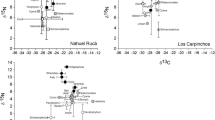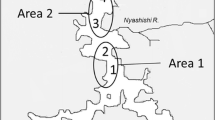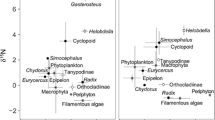Abstract
Resource–consumer relationships in Lake Victoria were investigated by use of stable isotope data. δ13C and δ15N signatures were determined for organisms at a deep (22 m) and a littoral (5 m) site in the Napoleon Gulf near Jinja, Uganda. Results suggest that two food chains operate at the deep site, one leading from a shrimp (Caridina nilotica) to juvenile Nile perch (Lates niloticus), the second leading from zooplankton (copepods and cladocerans) to a cyprinid (Rastrineobola argentea) and lake flies (Chaoborus). Isotopic evidence suggests that shrimp eat suspended particulates and benthos, not crustacean zooplankton or water hyacinth (Eichhornia crassipes). Resource–consumer relationships revealed in this study have implications for understanding future yields of the economically important Nile perch fishery.
Similar content being viewed by others
References
Adams, T. S. & R. W. Sterner, 2000. The effect of dietary nitrogen content on trophic level 15N enrichment. Limnol. Oceanogr. 45: 601–607.
Branstrator, D. K., J. T. Lehman & L. M. Ndawula, 1996. Zooplankton dynamics in Lake Victoria. In Johnson, T. C. & E. O. Odada (eds), The Limnology, Climatology and Paleoclimatology of the East African Lakes. Gordon and Breach, Amsterdam: 337–355.
Cabana, G. & J. B. Rasmussen, 1996. Comparison of aquatic food chains using nitrogen isotopes. Proc. Nat. Acad. Sci. U.S.A. 93: 10844–10847.
DeNiro, M. J. & S. Epstein, 1977. Mechanism of carbon isotope fractionation associated with lipid synthesis. Science 197: 261–263.
DeNiro, M. J. & S. Epstein, 1978. Influence of diet on the distribution of carbon isotopes in animals. Geochim. Cosmochim. Acta 42: 495–506.
DeNiro, M. J. & S. Epstein, 1981. Influence of diet on the distribution of nitrogen isotopes in animals. Geochim. Cosmochim. Acta 45: 341–351.
Fryer, G., 1957. The food of some freshwater cyclopoid copepods and its ecological significance. J. anim. Ecol. 26: 263–286.
Fryer, G., 1960. The feeding mechanism of some atyid prawns of the genus Caridina. Trans. R. Soc. Edin. 64: 217–244.
Gannes, L. Z., D. M. O’Brien & C. Martinez del Rio, 1997. Stable isotopes in animal ecology: assumptions, caveats, and a call for more laboratory experiments. Ecology 78: 1271–1276.
Gordon, I., 1930. African freshwater prawns of the species Caridina nilotica (Roux), with special reference to the Nile Basin. Proc. Zool. Soc. Lond. 3: 33–50.
Green, J., 1967. Associations of rotifera in the zooplankton of the lake sources of the White Nile. J. Zool. Lond. 151: 343–378.
Green, J., 1971. Associations of Cladocera in the zooplankton of the lake sources of the White Nile. J. Zool. Lond. 165: 373–414.
Hart, R. C., 2001. Rapid estimation of in situ growth rates of Caridina nilotica (Crustacea: Decapoda) in Lake Victoria: description and pilot application of a simple, field–compatible technique. Limnol. Oceanogr. 46: 692–698.
Hecky, R. E., 1993. The eutrophication of Lake Victoria. Verh. int. Ver. Limnol. 25: 39–48.
Hecky, R. E. & R. H. Hesslein, 1995. Contributions of benthic algae to lake food webs as revealed by stable isotope analysis. J. n. am. Benthol. Soc. 14: 631–653.
Hobson, K. A., R. T. Alisauskas & R. G. Clark, 1993. Stablenitrogen isotope enrichment in avian tissues due to fasting and nutritional stress: implications for isotope analysis of diet. Condor 95: 388–394.
Hughes, N. F., 1992. Nile perch, Lates niloticus, predation on the freshwater prawn, Caridina nilotica, in the Nyanza Gulf, Lake Victoria, East Africa. Envir. Biol. Fish. 33: 307–309.
Kitchell, J. F., D. E. Schindler, R. Ogutu–Ohwayo & P. N. Reinthal, 1997. The Nile perch in Lake Victoria: interactions between predation and fisheries. Ecol. Appl. 7: 653–664.
Lehman, J. T., 1991. Pelagic food webs of the East African great lakes. In Johnson, T. C. & E. O. Odada (eds), The Limnology, Climatology and Paleoclimatology of the East African Lakes. Gordon and Breach, Amsterdam: 281–301.
Lehman, J. T. & D. K. Branstrator, 1994. Nutrient dynamics and turnover rates of phosphate and sulfate in Lake Victoria, East Africa. Limnol. Oceanogr. 39: 227–233.
Lehman, J. T., G. B. Mbahinzireki & L. Mwebaza–Ndawula, 1996. Caridina nilotica in Lake Victoria: abundance, biomass, and diel vertical migration. Hydrobiologia 317: 177–182.
Lewis, W. M., 1977. Feeding selectivity of a tropical Chaoboruspopulation. Freshwat. Biol. 7: 311–325.
Mavuti, K. M. & M. R. Litterick, 1991. Composition, distribution and ecological role of zooplankton community in Lake Victoria, Kenya waters. Verh. int. Ver. Limnol. 24: 1117–1122.
Mbahinzireki, G. B., J. T. Lehman & H. Ocheng, 1998. Caridina nilotica: spatial distribution and egg production in Lake Victoria, Uganda. In Lehman, J. T. (ed.), Environmental Change and Response in East African Lakes. Kluwer, Dordrecht: 117–124.
Mwebaza–Ndawula, L., 1998. Distribution and abundances of zooplankton and Rastrineobola argentea (Pisces: Cyprinidae) and their trophic interactions in northern Lake Victoria, East Africa. Ph. D. dissertation, University of Vienna, Austria: 162 pp.
Minagawa, M. & E. Wada, 1984. Stepwise enrichment of 15N along food chains: further evidence and the relation between 15N and animal age. Geochim. Cosmochim. Acta 48: 1135–1140.
Ogutu–Ohwayo, R., 1990a. The decline of the native fishes of lakes Victoria and Kyoga (East Africa) and the impact of introduced species, especially the Nile perch, Lates niloticus, and the Nile tilapia, Oreochromis niloticus. Envir. Bio. Fish. 27: 81–96.
Ogutu–Ohwayo, R., 1990b. Changes in the prey ingested and the variations in the Nile perch and other fish stocks of Lake Kyoga and the northern waters of Lake Victoria (Uganda). J. Fish Biol. 37: 55–63.
Preuβ, A., R. Schauder & G. Fuchs, 1989. Carbon isotope fractionation by autotrophic bacteria with three different CO2 fixation pathways. Z. Naturforsch 44c: 397–402.
Talbot, M. R. & T. Laerdal, 2000. The Late Pleistocene–Holocene paleolimnology of Lake Victoria, East Africa, based upon elemental and isotopic analyses of sedimentary organic matter. J. Paleolimnol. 23: 141–164.
Wakeman, S. G., C. Lee, J. I. Hedges, P. J. Hernes & M. L. Peterson, 1997. Molecular indicators of diagenetic status in marine organic matter. Geochim. Cosmoch. Acta 61: 5363–5369.
Worthington, E. B., 1931. Vertical movements of fresh–water macroplankton. Int. Rev. ges. Hydrobiol. 25: 394–436.
van Dongen, B. E., S. Schouten & J. S. S. Damsté, 2002. Carbon isotope variability in monosaccharides and lipids of aquatic algae and terrestrial plants. Mar. Ecol. Prog. Ser. 232: 83–92.
Author information
Authors and Affiliations
Rights and permissions
About this article
Cite this article
Branstrator, D.K., Mwebaza-Ndawula, L. & Montoya, J.P. Resource–consumer relationships in Lake Victoria, East Africa. Hydrobiologia 493, 27–34 (2003). https://doi.org/10.1023/A:1025465119494
Issue Date:
DOI: https://doi.org/10.1023/A:1025465119494




